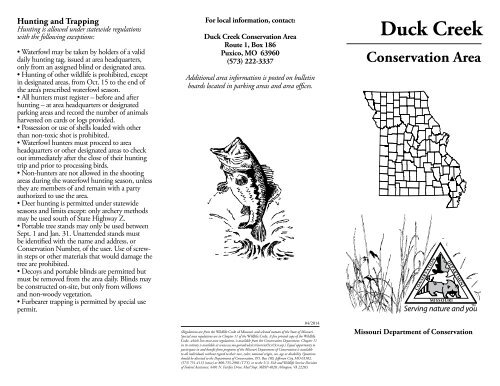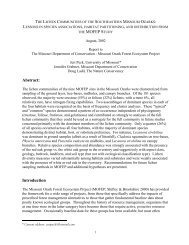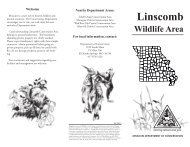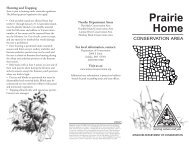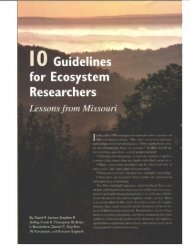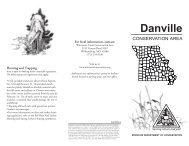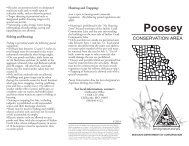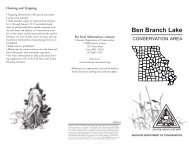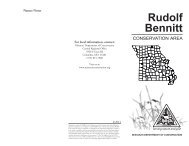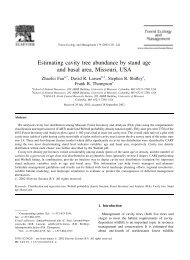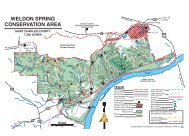Duck Creek Conservation Area - Missouri Department of Conservation
Duck Creek Conservation Area - Missouri Department of Conservation
Duck Creek Conservation Area - Missouri Department of Conservation
Create successful ePaper yourself
Turn your PDF publications into a flip-book with our unique Google optimized e-Paper software.
Hunting and Trapping<br />
Hunting is allowed under statewide regulations<br />
with the following exceptions:<br />
• Waterfowl may be taken by holders <strong>of</strong> a valid<br />
daily hunting tag, issued at area headquarters,<br />
only from an assigned blind or designated area.<br />
• Hunting <strong>of</strong> other wildlife is prohibited, except<br />
in designated areas, from Oct. 15 to the end <strong>of</strong><br />
the area’s prescribed waterfowl season.<br />
• All hunters must register – before and after<br />
hunting – at area headquarters or designated<br />
parking areas and record the number <strong>of</strong> animals<br />
harvested on cards or logs provided.<br />
• Possession or use <strong>of</strong> shells loaded with other<br />
than non-toxic shot is prohibited.<br />
• Waterfowl hunters must proceed to area<br />
headquarters or other designated areas to check<br />
out immediately after the close <strong>of</strong> their hunting<br />
trip and prior to processing birds.<br />
• Non-hunters are not allowed in the shooting<br />
areas during the waterfowl hunting season, unless<br />
they are members <strong>of</strong> and remain with a party<br />
authorized to use the area.<br />
• Deer hunting is permitted under statewide<br />
seasons and limits except: only archery methods<br />
may be used south <strong>of</strong> State Highway Z.<br />
• Portable tree stands may only be used between<br />
Sept. 1 and Jan. 31. Unattended stands must<br />
be identified with the name and address, or<br />
<strong>Conservation</strong> Number, <strong>of</strong> the user. Use <strong>of</strong> screwin<br />
steps or other materials that would damage the<br />
tree are prohibited.<br />
• Decoys and portable blinds are permitted but<br />
must be removed from the area daily. Blinds may<br />
be constructed on-site, but only from willows<br />
and non-woody vegetation.<br />
• Furbearer trapping is permitted by special use<br />
permit.<br />
For local information, contact:<br />
<strong>Duck</strong> <strong>Creek</strong> <strong>Conservation</strong> <strong>Area</strong><br />
Route 1, Box 186<br />
Puxico, MO 63960<br />
(573) 222-3337<br />
Additional area information is posted on bulletin<br />
boards located in parking areas and area <strong>of</strong>fices.<br />
04/2014<br />
(Regulations are from the Wildlife Code <strong>of</strong> <strong>Missouri</strong> and selected statutes <strong>of</strong> the State <strong>of</strong> <strong>Missouri</strong>.<br />
Special area regulations are in Chapter 11 <strong>of</strong> the Wildlife Code. A free printed copy <strong>of</strong> the Wildlife<br />
Code, which lists most area regulations, is available from the <strong>Conservation</strong> <strong>Department</strong>. Chapter 11<br />
in its entirety is available at www.sos.mo.gov/adrules/csr/current/3csr/3csr.asp.) Equal opportunity to<br />
participate in and benefit from programs <strong>of</strong> the <strong>Missouri</strong> <strong>Department</strong> <strong>of</strong> <strong>Conservation</strong> is available<br />
to all individuals without regard to their race, color, national origin, sex, age or disability. Questions<br />
should be directed to the <strong>Department</strong> <strong>of</strong> <strong>Conservation</strong>, P.O. Box 180, Jefferson City, MO 65102,<br />
(573) 751-4115 (voice) or 800-735-2966 (TTY), or to the U.S. Fish and Wildlife Service Division<br />
<strong>of</strong> Federal Assistance, 4401 N. Fairfax Drive, Mail Stop: MBSP-4020, Arlington, VA 22203.<br />
<strong>Duck</strong> <strong>Creek</strong><br />
<strong>Conservation</strong> <strong>Area</strong><br />
<strong>Missouri</strong> <strong>Department</strong> <strong>of</strong> <strong>Conservation</strong>
About this <strong>Area</strong><br />
<strong>Duck</strong> <strong>Creek</strong> <strong>Conservation</strong> <strong>Area</strong> is a remnant<br />
<strong>of</strong> the bottomland hardwood forest that<br />
once covered southeastern <strong>Missouri</strong>. Part <strong>of</strong><br />
the area lies in the foothills <strong>of</strong> the Ozarks<br />
with the majority in the ancient floodplain<br />
<strong>of</strong> the Mississippi River. The 6,318-acre<br />
area contains a wide variety <strong>of</strong> habitat types<br />
and supports an abundance <strong>of</strong> plant and<br />
animal species, many <strong>of</strong> which are unique<br />
to <strong>Missouri</strong>. The <strong>Conservation</strong> <strong>Department</strong><br />
purchased land for <strong>Duck</strong> <strong>Creek</strong> <strong>Conservation</strong><br />
<strong>Area</strong> in 1950 in order to establish a waterfowl<br />
hunting area in conjunction with Mingo<br />
National Wildlife Refuge. The area presently<br />
is managed to provide a diversity <strong>of</strong> food<br />
and shelter for both resident and migratory<br />
wetland wildlife. Management <strong>of</strong> the area<br />
centers upon manipulation <strong>of</strong> water levels<br />
on about 2,400 wetland acres. Open marsh<br />
areas (moist soil units) within the wetland<br />
area are seasonally flooded and drained to<br />
provide a variety <strong>of</strong> natural foods - seeds,<br />
tubers and insects - for waterfowl and other<br />
wildlife. The heart <strong>of</strong> the wetland system is<br />
Pool 1, a 1,800-acre man-made reservoir. It<br />
supplies water to mimic the flooding that<br />
once occurred naturally. Deep wells provide<br />
additional water for flooding. The area’s<br />
forest and scattered foodplots also provide<br />
wildlife foods. Approximately 1,500 acres<br />
<strong>of</strong> native bottomland hardwoods supply<br />
acorns and invertebrates that are eaten by<br />
dabbling ducks, turkeys, deer and squirrels.<br />
The herbaceous wetland units are managed<br />
primarily to encourage the growth <strong>of</strong> diverse<br />
native plant communities, primarily moist<br />
soil plants which consist <strong>of</strong> annual species like<br />
millets, smartweeds and sedges. Invertebrates<br />
such as crawfish, mollusks, insects and their<br />
larvae are also abundantly produced in these<br />
wetlands which provide an important dietary<br />
component for migrating water birds.<br />
RECREATIONAL OPPORTUNITIES<br />
Bicycling — Bird Watching — Fishing<br />
Hiking — Horseback Riding — Hunting<br />
Wildlife Viewing<br />
<strong>Conservation</strong> <strong>Area</strong>s are closed from 10 p.m. to 4<br />
a.m. except for authorized camping, fishing and<br />
hunting activities.<br />
• Dogs must be leashed when not used for<br />
training or hunting.<br />
• Training <strong>of</strong> hunting dogs is permitted only by<br />
holders <strong>of</strong> a valid area dog training permit during<br />
dates and hours established for this activity.<br />
• Special use permits are required for field and<br />
retriever trials and dog training.<br />
• Nuts, berries, fruits, mushrooms and wild<br />
greens may be taken for personal use. Cutting or<br />
removing other vegetation, except for willows and<br />
non-woody vegetation to construct temporary<br />
blinds, is prohibited.<br />
• Bicycles and horseback riders are permitted<br />
only on designated multi-use trails and on roads<br />
open to vehicular traffic, unless otherwise posted.<br />
Groups <strong>of</strong> 10 or more need a special use permit.<br />
• Primitive camping is permitted only in<br />
designated areas on the area map and stays<br />
are limited to 14 consecutive days in a 30-day<br />
period. Personal property must be removed at<br />
the end <strong>of</strong> the 14-day period. Total camping<br />
days on all department lands are limited to 30<br />
days within one calendar year. Groups <strong>of</strong> 10 or<br />
more campers must obtain a special use permit.<br />
• Hiking is permitted on interior roads and trails<br />
except from October 15 through the end <strong>of</strong> the<br />
prescribed waterfowl season or in designated<br />
waterfowl refuge and hunting areas.<br />
• For safety reasons target shooting is permitted<br />
only at the shooting range (archery only).<br />
Fishing and Boating<br />
Fishing and frogging are allowed under statewide<br />
regulations with the following exceptions on<br />
impoundments:<br />
• Fishing is permitted in designated areas,<br />
except from Oct. 15 through the last day <strong>of</strong> the<br />
prescribed duck season.<br />
• On Pool 1 fish may be taken only by pole and<br />
line and not more than three poles may be used<br />
by any person.<br />
• Daily limit is 6 black bass, 6 pickerel, 4 catfish<br />
(includes channel, blue and flathead) and 30<br />
crappie. Total number <strong>of</strong> all other fish may not<br />
exceed 50.<br />
• All black bass between 12 and 15 inches must<br />
be released unharmed immediately after being<br />
caught.<br />
• Carp, buffalo and gar may be taken by gig,<br />
longbow or crossbow during statewide seasons;<br />
non-game limit is 20.<br />
• Seining or trapping live bait, including<br />
tadpoles, is prohibited.<br />
• Boats may be used only for fishing and wildlife<br />
activities and may not stored or left unattended<br />
overnight.<br />
• Outboard motors in excess <strong>of</strong> 10 horsepower<br />
are permitted on area lakes and impoundments<br />
at no wake speed.


